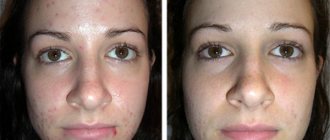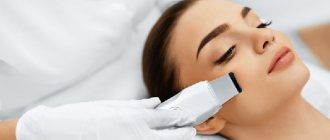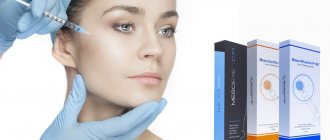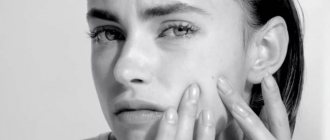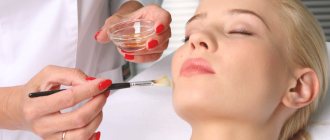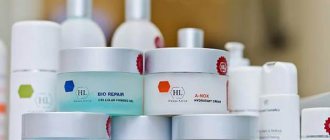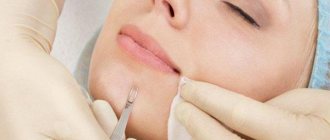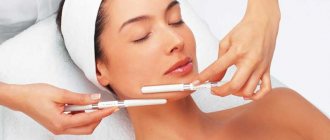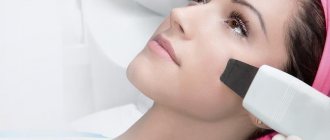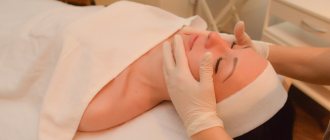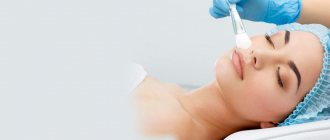Peeling and facial cleansing remain the most popular cosmetic procedures among girls. Patients regularly ask doctors questions about what is more effective. The answer may puzzle fans of manual or hardware skin care methods: it is incorrect to compare the effect of these procedures.
The fact is that the indications for peeling and cleansing are different. Peeling is the removal (exfoliation) of skin cells. During peeling, it is as if we are removing the top layer of the epidermis, and our skin becomes smoother, smoother, more radiant, superficial wrinkles disappear, gloss and well-groomed appearance appear.
The main task of facial cleansing, as the name suggests, is deep cleansing, a kind of skin hygiene. During cleansing, we open the pores and clean them, removing excess sebum, environmental pollution, etc. As a result of facial cleansing, the skin begins to breathe, inflammation and blackheads are reduced, oily shine goes away, and the skin becomes healthier.
Both one and the other procedures, or even a combination of them, can show better effectiveness in solving various problems - it all depends on the available indications.
Basic information about peeling
The name of the procedure comes from the English verb to peel, which means the action of peeling or exfoliating a fruit. The key task of peeling is to eliminate dead epidermal cells and create conditions for the active growth of new ones. The procedure is performed in aesthetic clinics using special compounds or devices that are recognized to speed up the process of renewing the skin of patients due to their initial injury.
Indications for the procedure
Cosmetologists recommend peeling for patients in the following cases:
- reduction of natural skin radiance;
- roughening of the skin, loss of its softness and elasticity;
- “gray”, uneven complexion;
- increased oiliness of the skin;
- uneven relief, the presence of small scars and cicatrices;
- the presence of blackheads and acne;
- age-related or solar pigmentation;
- pronounced signs of photoaging.
The type of peeling is determined by the doctor at the cosmetology clinic after examining the patient. For girls 18-25 years old, the procedure is recommended to eliminate aesthetic skin imperfections. After 35 years, peeling is considered as an anti-aging therapy tool.
Types of peelings
The procedure is classified based on the depth of damage to the epidermis. Cosmetologists distinguish between superficial, medium and deep types of peeling.
Superficial peeling removes the very top layer of skin cells, which improves its color, smoothes out surface wrinkles, slight hydration, and a soft, light skin renewal effect. All home peels are superficial. They are as safe as possible and do not require restoration.
Medium peeling affects the deeper layers of the skin. Such peelings more effectively correct pigmentation, medium and deep wrinkles, and provide more noticeable hydration and rejuvenation of the skin. Medium peeling requires rehabilitation from several days to a week. Laser resurfacing procedures have become a modern alternative to medium peels, allowing cosmetologists to work safely and in a controlled manner at different depths, achieving excellent results in skin smoothing and rejuvenation.
The most serious peeling is deep, it reaches the deepest layers of the dermis. This procedure must be performed in a surgical setting. Currently, deep peeling is performed extremely rarely, giving way to safer methods of rejuvenation.
The choice of peeling is agreed upon with the patient after the initial examination. The doctor’s recommendations are based on the current condition of the patient’s skin, time of year, and the presence of certain indications.
Expected results of the procedure
The rehabilitation period after professional peeling can take one to two days for superficial effects and up to seven days for deeper effects on the patient’s skin. The result of the procedure is:
- evens out skin tone and improves its quality;
- natural hydration;
- increasing skin density;
- reduction of pigmentation, wrinkles;
- even out complexion;
- reduction of blackheads;
- acne treatment;
- skin glow.
Recommendations from cosmetologists
Chemical peeling and facial cleansing are procedures that, to a greater or lesser extent, still injure the epidermis. Cosmetologists advise following simple rules to speed up the recovery process.
After peeling you need:
- do not wet your face for 24 hours (if you used deep chemical peeling – up to 3-4 days);
- Do not remove developing crusts under any circumstances;
- do not visit places with high humidity and air temperature (sana, bathhouse, swimming pool, beach);
- do not sunbathe or visit a solarium;
- do not use products containing alcohol;
- apply moisturizing and nourishing creams according to your skin type;
- Use sunscreen before going outside.
After cleansing your face you should:
- do not wash your face for a day, wipe your face with soothing, cleansing lotions without alcohol;
- Do not forcibly tear off crusts if they form;
- do not expose your face to sunlight for two days;
- sauna, baths, swimming pools, beaches - taboo for at least a week;
- preference should be given to cleansing gels and alcohol-free lotions with a calming effect;
- Apply moisturizing and nourishing products according to your skin type. If necessary, use healing ointments.
The cosmetologist will tell you how often to do the procedure.
Basics of facial cleansing
Facial cleansing can be manual or combined. The main purpose of cleansing is deep cleansing and hygiene of the skin, opening pores, removing acne, comedones, and blackheads.
An aesthetic clinic doctor can use only his hands and special tools for manual cleaning, or he can resort to an ultrasonic spatula, cosmetics and chemical compositions, combining these techniques to achieve maximum results. Most often, cleaning is a combined procedure, consisting of several stages, one of which is peeling.
As a rule, 2 types of peeling are involved in combined cleaning. The first is chemical peeling, when the doctor prepares the skin for deep cleansing with a weak acid solution. Peeling opens pores and removes excess horny scales.
The second stage is physical (ultrasonic) peeling. Using a pulsating ultrasonic wave, the remains of keratinized particles are removed and the contents of the pores are removed. Then the doctor manually cleanses deeply clogged pores, eliminates comedones and completes the cleansing procedure by applying a mask that soothes the skin and closes the pores back.
Indications and contraindications for cleaning
Cosmetologists recommend facial cleansing for everyone, especially those with oily and problematic skin. The interval between procedures is determined by the doctor depending on the condition of the skin; some people need to visit a cosmetologist once every 4 weeks, while for others, 1 session every six months or a year is enough.
Expected effect of the procedure
The main result is cleansing of pores, getting rid of blackheads and acne. Deep cleansing of facial skin pores leads to the following changes:
- the general condition of the skin improves;
- comedones, blackheads, inflammation are reduced;
- greasy shine disappears;
- the skin becomes smoother;
- pores become less noticeable;
- the effectiveness of using care products increases.
What is cleansing?
Reference. Facial cleansing includes removing excess oil and makeup from the surface of the skin, as well as deep cleansing the pores of dirt and sebaceous plugs.
Some substances cannot be eliminated by washing alone. For example, from toxins, dust particles with heavy metals that the air contains in megacities. Skin with inflammation, blackheads, and impaired sebum production also needs additional cleansing.
Sometimes ordinary home procedures are not enough, and you have to resort to hardware methods, use tools and special cosmetics.
Distinctive features of peeling and mechanical facial cleansing
The main differences between the procedures are presented in the table. Patients should remember that the choice of facial skin care procedure should be made after consultation with a cosmetologist. Turning to professionals working at home can lead to irreversible damage to the epidermis and dermis, exacerbation of acne and the development of various skin pathologies.
| Parameter | Peeling | Cleaning |
| The essence of the procedure | Renewal of the upper layer of skin, exfoliation of old, keratinized epidermal cells, smoothing of skin texture. | Cleansing pores, eliminating excess sebum, leading to the formation of comedones, blackheads, purulent inflammation. |
| Indications | Uneven tone, color and texture of the skin, loss of elasticity, roughening of the skin, pigmentation, wrinkles. | Excessive work of the sebaceous glands and, as a result, local rashes - acne, comedones, blackheads, oily sheen. |
| Execution frequency | Procedures are prescribed in a course with a short interval (1-2 weeks) | From 1 time per month to 1 time per year in accordance with individual patient indications |
| Rehabilitation period | From 1 to 10 days depending on the depth of exposure. | From 1 to 5 days |
| Seasonality | The period recommended by cosmetologists is from September to April (during the months of active sun, peelings are recommended to be avoided due to the risk of pigmentation formation) | Any time throughout the calendar year |
The effectiveness of each procedure depends on several factors:
- patient's skin condition;
- age, hormonal levels;
- facial care products used;
- daily diet and physical activity;
- environmental situation in the region of residence;
- skills of a cosmetologist.
Cleaning provides the best results in the fight against acne; peeling is preferable for renewing and smoothing the skin, correcting wrinkles and areas of pigmentation. A direct comparison of the effectiveness of both methods will not be entirely correct due to different indications for their use. Cosmetologists recommend combining peelings and mechanical cleansing.
To combine or not to combine - that is the question
Peeling and cleansing, by and large, are procedures designed to solve the same issues. This is their similarity. But the mechanism of action is completely different. We conclude that they may well complement each other, especially when solving significant problems.
The question naturally arises: is it necessary to cleanse the face before peeling? What is better - peeling or cleansing first? Is it possible to exfoliate without cleansing your face and vice versa?
Don't try to solve this dilemma on your own. Leave it to the professionals to decide what to do in each case. Only after diagnosis will they tell you what is best.
Summary
Salon procedures designed to make a woman’s appearance more attractive, get rid of defects, and stop aging are excellent methods. But you need to understand the nuances even before going to a cosmetologist.
Whether you can peel after cleansing your face depends on your individual characteristics. We can definitely say that such a procedure is unlikely to be carried out right away. After all, the skin must recover from previous exposure. Remember these nuances.
And most importantly, look for “your own,” experienced, responsible cosmetologist. Only then can you be 100% sure.
How to choose depending on age and skin type
Age and skin type are two main factors that are important to consider when choosing any cleansing routine.
Face cleaning:
- Normal skin, without acne, pimples and blackheads - ultrasonic cleansing with a spatula attachment.
- Oily type, with a small number of rashes and blackheads - a session of manual procedure or with the Unna instrument, or as a gentle option - biorevitalization.
- Dry type – laser biorevitalization or ultrasound.
- Problematic skin (cleansed after inflammation has subsided) – vacuum or deep ultrasonic cleaning.
Peeling:
- Normal epidermis with the first signs of wilting - a superficial procedure (fruit acids, scrubbing, etc.).
- Oily type – cleansing with hyaluronic acid, microdermabrasion or brosage.
- Dry, sensitive epidermis - cream peeling, rolling, laser resurfacing, ultrasound.
- Problematic surface of the face - salt peeling, Jessner or yellow (retinoic).
Preparation for procedures
The basis of preparation for any skin cleansing procedure is maintaining the health of the epidermis. Interventions are not carried out if there is inflammation, irritation, or damage on the surface. It is recommended to postpone manipulation during periods of illness, poor health, taking antibiotics, hormones, or during menstruation. Unstable hormonal levels and reduced immunity will slow down the recovery process.
During the preparation period, it is recommended to give up alcohol and other bad habits. It is advisable to lead a healthy lifestyle: eat right, follow a sleep schedule, and drink enough fluids.
To facilitate the cleansing process, it is recommended to introduce into your regular care routine the use of products that have a loosening effect on the skin. This will soften the stratum corneum and the contents of the pores. The cosmetologist will tell you whether it is necessary to change the care system in any other way.
Important! Immediately before the cleansing procedure, it is recommended to steam the epidermis. This is performed in conjunction with basic sanitizing actions. Manipulation allows you to maximally prepare the tissue for the basic procedure.
Combination of cleansing effects
It is not recommended to combine standard cleaning and peeling into a single complex. Each impact injures tissue and requires time for effective recovery. Simultaneous cleaning and peeling can lengthen and complicate rehabilitation.
Cosmetologists sometimes combine different types of cleansing, focusing on the individual characteristics of the patient. The doctor assesses the current situation and makes a decision. It is not recommended to prescribe the steps of a cleansing program on your own.
Different types of effects (cleaning, peeling) complement each other perfectly if performed in a light version. Before cleaning, it is useful to carry out a superficial chemical peel using solutions of minimal concentrations. A similar effect can “close” cleaned pores.
Carrying out traumatic cleansing immediately before peeling is of dubious benefit. It is recommended to do without classical cleaning. In anticipation of exfoliation, it is better to use a steaming, deep cleansing mask that will open the pores and remove excess dirt.
You should be especially wary of traumatic effects before performing medium, deep peels. Cleaning is prohibited before carbon, salicylic or retinol exfoliation, which involves complex rehabilitation.
Reviews
We have already figured out how peeling differs from facial cleansing. Reviews will help you get a complete picture.
Victoria, 25 years old, Moscow
“I cleanse regularly because I have oily, problematic skin. Recently, a cosmetologist advised me to peel my face with fruit acids a week after cleansing. The effect is amazing. This procedure complemented the cleaning, made it better and longer lasting.”
Marina, 32 years old, Ramenskoye
“When I asked what is better to cleanse my face - peeling or ultrasonic cleansing, the master at the salon told me that it was too early for me to think about peeling, since the skin looked quite good. I understand that it is not at all necessary to “burn” your face unless absolutely necessary.”
Oksana, 48 years old, St. Petersburg
“I did peeling with liquid nitrogen. The exfoliation took place for at least two weeks. It’s good that you took a vacation, otherwise at least don’t show up for work. But there is an effect - the face has become fresher, the spots have disappeared"
Tatyana, 40 years old, Ryazan
“Ultrasound facial cleansing is the best procedure for me. I do it regularly and am quite pleased with the result. But a friend went to get a chemical peel and I didn’t see her for a month. She didn't even invite me to visit. Only later did she tell me what a nightmare it was. I definitely won’t do that.”
Olga, 35 years old, Tomsk
“I have been using scrubs with fruit acids on my own for a very long time. As it turned out, this is also peeling, which is not so scary. It’s probably time to contact a cosmetologist for a professional service.”
